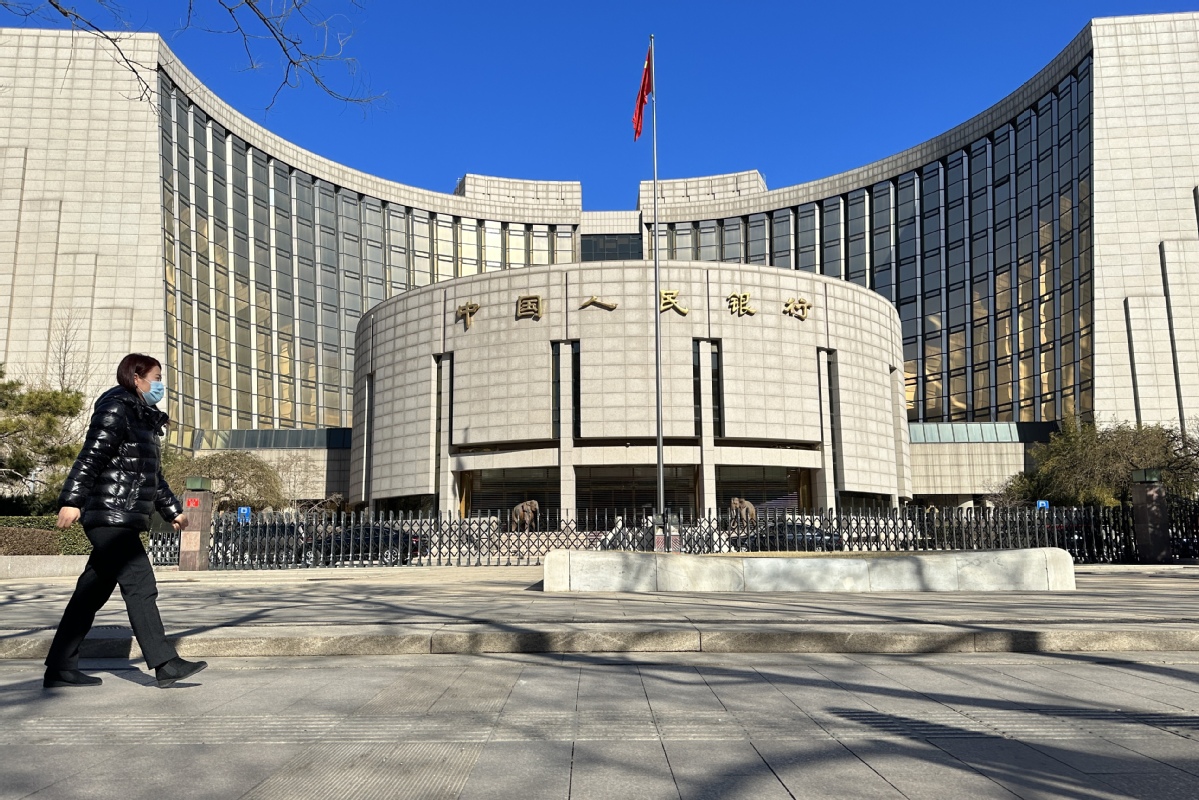Source:China Daily 2023-12-18
Editor's note: How will China's economy develop next year? Three economists share their views with China Daily.

MA XUEJING/CHINA DAILY
A slower, but healthier dragon year
By Louise Loo
China heads into 2024 with relatively loose policy settings, but private sector sentiment constrained by property pessimism. Stimulus will reduce tail risks but we don't expect it will be sufficient to prevent the downtrend in growth to persist. We think three key themes will shape the macro outlook in 2024.
First, the economy will muddle through a tightly managed, multi-year clean-up process. The old "pre-sales" commodity housing model no more exists. Transitioning to a new model that boosts the role of State-directed public and social housing could prompt further consolidation among onshore property developers. There may be bouts of credit stress, but they're unlikely to be systemic.
Recent policy signals suggest that the real estate sector is pivoting toward a new model of increased social housing, in which the government takes a more active role in housing provision through land development, upgrading and renovation, and potentially, price subsidies. In this new "normal", the pace of housing sales will not revert to the pre-tightening (2021) trend in 2024.
At the same time, write-downs on housing inventories will weigh heavily on the balance sheets of property developers, who, faced with liquidity challenges and still-tentative demand, will likely experience increased credit stress. Episodic credit events will persist so long as the "stock" problem of the sector remains unresolved, and we think authorities' policy response will be similar to that in 2023 — at arm's length when it comes to single-name default risks, but deploying a range of monetary support and credit provisions to mitigate a collapse in the sector's "flow" activity, such as the recently-reported "white list" of developers eligible for additional funding.
However, the uncertainty around this assumption is admittedly high; there is no clear precedent for a housing downturn where property easing comes with stringent macroprudential guardrails for developers. On balance, we think the sector will continue to tread a long "staircase-shaped" recovery path — reflecting periods of idiosyncratic risk punctuated by periods of reactive stabilization efforts.
For households, the negative wealth effects of a continued housing correction will undermine consumer spending, which we think will slow to 5.2 percent in 2024 from 8.7 percent this year and continue to underperform the average pre-pandemic growth pace over the next five years. In 2024, this spending will to some extent be bolstered by a recovering labor market and wage growth.
Second, China is no longer the spender of last resort for the global economy, so don't expect robust reflation. Accelerating efforts to resolve local government debt issues will put increasing onus on centrally funded tools for countercyclical policies, while top-down pressure to deliver on growth in 2024 will likely be less acute. A more disciplined approach to capital allocation will drive only a small uptick in the overall fiscal impulse. Inflation should stage an unspectacular ascent as supply-side disinflationary pressures fade.
Local governments are no longer the engines of growth. Next year will also feature a continued cleanup in local government debt, in turn pushing the onus of countercyclical policymaking onto the central government authorities. Official central government debt was only 21 percent of GDP(end-2022), while the People's Bank of China's total assets were only around 35 percent of GDP(end-Oct), suggesting good headroom for further stimulus.
In our view, the steady focus on financial stability means the State Council's hawkish tone on local government finances during 2023 is set to stay. Cleaning up local government financing vehicle debt is a balancing act between introducing moral hazard and managing systemic risk, possibly leading to an uninspiring stream of mild corrective policies in 2024, focused initially on identifying and stabilizing the level of implicit debt in the system. Further steps that encourage debt swaps of local governments' implicit liabilities, the rollover of these debts by State banks, and the commercialization of some local government financing vehicle operations are also likely.
Our assessment of next year's growth target — and hence stimulus — is a benign one. Where the total government debt trend goes from here depends crucially on how much of a slowdown the authorities are prepared to tolerate. Our view is that the top-down pressure to deliver on growth is still elevated but has receded somewhat, and an increasingly disciplined approach to capital allocation will constrain the overall fiscal impulse in 2024 to only a very small uptick. This is a conservative take relative to the prevailing market view of a possible "close to 5 percent" growth target in 2024.
Our judgment is that it is indeed possible, though not likely, that the authorities ultimately choose to stimulate their way to a high growth target for 2024.
Third, the investment recovery will be very sector-specific. The persistence of domestic regulatory uncertainties will temper the investment recovery, excluding property, in 2024. Sectors that benefit from policy tailwinds, plus high value-added manufacturing such as consumer electronics and autos, are likely to outperform.
Within manufacturing, emerging new industries — such as the ones authorities dub "the three new": batteries, renewables, and EVs, as well as high-technology manufacturing segments — will continue to expand rapidly in 2024, driven by policy tailwinds and still-resilient external and domestic demand in these areas.
Domestically, a top-down re-emphasis of the "Common Prosperity" framework across policymaking organs means that sectors such as consumer durables (e.g., high-tech goods), green technology and social and welfare segments such as pharmaceuticals and accommodation, are likely to emerge as longer-term winners.
Investments will be skewed toward strategic industries. Against a likely backdrop of stabilizing, though uninspiring, external demand, a bottoming out in industrial profits in 2023, and policy support for high-end manufacturing, investments outside of property are likely to gain further ground in 2024, to 4.2 percent from 3.4 percent this year. Private and public investments will continue to diverge, with the latter driven by ongoing fiscal stimulus.
Our 2024 forecast is: GDP growth to decelerate to 4.4 percent (consensus, 4.6 percent); inflation at 1.2 percent (consensus, 1.7 percent); nominal total social financing growth at 9.7 percent (down from 9.9 percent). With domestic fundamentals stabilizing and narrowing rate differentials with the US, the dollar-renminbi ratio should strengthen toward the 7.0-band by end-2024.
Our forecast also assumes that geopolitical tensions, including friction with the US over technological supremacy, and export controls, remain sufficiently well-contained to prevent a sharp collapse in investment in 2024. Still, the latent risk from ongoing China-US tensions will continue to drive firms' "friend-shoring" considerations, leading to further global economic fragmentation in the longer run.
The author is lead economist at Oxford Economics. The views don't necessarily represent those of China Daily.

A pedestrian walks past the headquarters of PBOC in Beijing. [JIANG QIMING/CHINA NEWS SERVICE]
China: Waiting for policy tailwind
By Xiong Yi
A year after the restrictions imposed because of the COVID-19 pandemic were lifted, China's economic recovery still lacks enough momentum. One thing is clear: China's economy as of today is operating at below potential. We believe a sizable negative output gap emerged in 2022 that has persisted in 2023, judging from the low capacity utilization rates, labor market slack, weak credit demand and, most importantly, negative consumer and producer prices inflation. Therefore, China's potential for growth should be higher than the 4.1 percent average growth in 2022-23. In our view, it should be in the 4.5-5 percent range. Growth could be even higher for a short period, if the economy can enter a cyclical rebound to close the negative output gap.
That cyclical rebound hasn't happened yet, primarily because after a prolonged property sector downturn and a sharp drop in inflation, a vicious loop has emerged among consumer spending, business profits and forward expectations for income and prices. A positive shock is required to break the loop. Unfortunately, both external demand and public spending have contracted for most of 2023, thus reinforcing rather than breaking this vicious circle.
Only the government can jump-start the economy through forceful and coordinated policy responses. The most important policy variable is the government's 2024 growth target. Our base case is the government will likely commit to boost growth by setting a growth target at "above 4.5 percent" for 2024, moderately higher than the 4.1 percent average growth in 2022-23. This will be consistent with our 4.7 percent real GDP growth and 1 percent inflation forecasts in 2024.
While the People's Bank of China will continue to ease lending conditions, to bring about recovery in the property market, more decisive fiscal policy support is necessary to see China's growth stabilizing at 4.7 percent in 2024, as per our forecast.
Fiscal expansion is the most effective policy tool to stimulate demand and boost prices in today's low-growth, low-inflation environment. The government finally changed its fiscal stance in Q3 by accelerating spending, helping local governments with their debt problems and, more recently, announcing stimulus packages for infrastructure investment and housing construction. It has also broken the long-standing 3 percent of GDP "glass ceiling" on budgetary deficits. We expect the fiscal stance will be 1.5-2 percent of GDP more expansionary in 2024, assuming the government will set a 3.8 percent of GDP fiscal deficit target, fully implement the 1 trillion yuan ($140.69 billion) infrastructure stimulus, and tap the PBOC's pledged supplementary lending facility for public housing projects.
Additional monetary easing is also warranted in 2024. We expect the PBOC to cut the medium-term lending facility rate by another 45 basis points before mid-2024 to bring bank interest rates below the natural rate. It will likely also cut the reserve requirement ratio by another 50 basis points, and inject liquidity through pledged supplementary lending and other long-term lending facilities, to make sure there's sufficient liquidity in the financial system to accommodate the upcoming fiscal expansion.
US/China growth dynamics and interest rate differentials will likely turn more favorable for the renminbi. The US economy is expected to enter a mild recession in the first half of 2024. The Fed is expected to cut interest rates by a total of 150 bps before year-end, 100 bps more than the expected cut by the PBOC. The renminbi will be supported by a sustained current account surplus and a reduction of capital outflows. We therefore expect the yuan will appreciate modestly by the end of 2024.
The author is China chief economist at Deutsche Bank. The views don't necessarily represent those of China Daily.

A woman selects vegetables at a supermarket in Huaihua city of Hunan province, Oct 13, 2023. [Photo/Xinhua]
Consumption and investment fuel growth amid challenges
By Albert Park
The Chinese economy grew by 4.9 percent in Q3 from the same quarter in 2022, bringing the growth for the first three quarters of 2023 to 5.2 percent.
East Asia's growth forecast for 2023 has revised up to 4.7 percent on higher-than-expected third quarter growth in China. The forecast for 2024 is maintained at 4.2 percent.
The Q3's growth was primarily driven by household consumption and public investment. Weak demand for exports and the real estate crisis continued to weigh on growth. To offset softer external demand and a prolonged property downturn, policy support is expected to continue.
In October, the Chinese authorities announced to issue treasury bonds of 1 trillion yuan ($140.69 billion) in Q4 to finance local government disaster prevention and recovery spending. The bonds will be split into two tranches, with 500 billion yuan (equivalent to 0.4 percent of GDP) to be used this year and the rest in 2024. The bond issue will cause the budget deficit to increase to 3.8 percent of GDP from 3.0 percent, and shows the government's determination to stabilize the economy.
Consumption and private investment are still regaining their footing, and the property sector remains contractionary. Although the growth momentum in services continues, latest PMI readings point to relatively weak manufacturing demand. The growth forecast for 2023 is revised up to 5.2 percent; the forecast for 2024 is unchanged.
The author is chief economist at Asian Development Bank. The views don't necessarily represent those of China Daily.
If you have a specific expertise, or would like to share your thought about our stories, then send us your writings at opinion@chinadaily.com.cn, and comment@chinadaily.com.cn.
Copyright © Xizang Daily & China Xizang News All rights reserved
Reproduction in whole or in part without permissions prohibited
Index Code: 藏 ICP 备 05000021 号
Producer: Xizang Daily International Communication Center